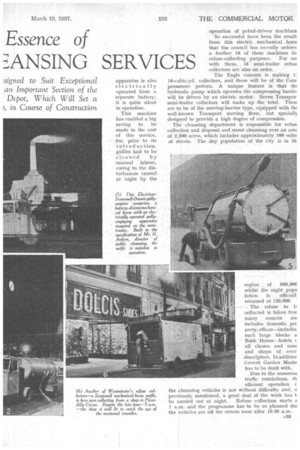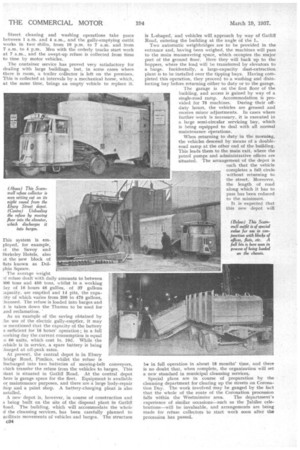Silence the
Page 82

Page 83

Page 84

If you've noticed an error in this article please click here to report it so we can fix it.
Essence of
WESTMINSTER'S a =1ANSING SERVICES
IXTESTMINSTER, the heart of the British Empire, is virtually a city within a city. An exceptionally busy centre, containing a wide diversity of buildings, it sets its cleansing department a number of problems not commonly encountered in other cities and towns. Of primary importance is the fact that, due to heavy traffic conditions and local restrictions, a big proportion of the work has to be carried out at night. Since there is a good deal of residential property in the city, the question of silent operation has had to be carefully studied,
The cleansing department, under the direction of Mr. H. Ardern, A.M.I.Mech.E., has not been afraid, however, to introduce new methods and devise machines specially adapted to deal with the conditions prevailing. It is safe to say that, in the field of public cleansing, Westminster is in the forefront in its adoption of modern equipment, whilst the progressive methods , employed set a high . standard of efficiency.
The fleet comprises 20 Scammell mechanical horses, which are used both for refuse collection and street cleaning. Operated in conjunction with these are 18 semi-trailer refuse collectors, 11 street washers and four container outfits, for dealing with large blocks of offices, fiats, etc.
Three Karrier sweeper -collectors are also in service, whilst the remainder of the refuse-collection fleet is made up of 11 Thornycrofts, 10 Karriers and seven Daimlers; 170 Bristow orderly trucks are used for street sweeping.
Gully emptying is carried out by an electrically operated mechanical-horse outfit, produced to the c32
specification of Mr. Ardern by the ' Electricar, Scammeil a n d Dennis. concerns. This unusual appliance was fully described in the issue of The Commercial Motor dat ed May 15, 1936. It will be remembered that, not only is the tractor battery driven, but the pump for the gully cleansing
apparatus is also electrically operated from a separate battery; it is quite silent in operation.
This machine has enabled a big saving to be made in the cost of this service, for, prior to its introduction, gullies had to be cleaned by manual labour, owing to the disturbances caused at night by the operation of petrol-driven machines So successful have been the result: from this electric mechanical horst that the council has recently orderec a further 18 of these machines fo: refuse-collecting purposes. For us( with them, 18 semi-trailer refust collectors are also on order.
The Eagle concern is making 11 18-cubic-yd. collectors, and these will be of the Corn pressmore pattern. A unique feature is that tht hydraulic pump which operates the compressing barrie, will be driven by an electric motor. Seven Transpor semi-trailer collectors will make up the total. Thes( are to be of the moving-barrier type, equipped with tht well-known Transport moving floor, but speciall3 designed to provide a high degree of compression.
The cleansing department is responsible for refusi collection and disposal and street cleansing over an areLof 2,500 acres, which includes approximately 100 mile! of streets. The day population of the city is in th
region of 500,000 whilst the night popu lation is official': returned at 120,000.
The refuse to b collected is takenfrot many sources an' includes domestic prc perty, offices—includin. such large blocks a Bash House—hotels c all classes and• size: and shops -of ever description. In additior Covent Garden Mark: has to be dealt with.
Due to the numerou traffic restrictions, th efficient operation c the cleansing vehicles is not without difficulty and, a previously mentioned, a good deal of the work has t be carried out at night. Refuse collection starts a 1 a.m. and the programme has to be so planned tha the vehicles are off the streets soon after 10.30 a.m.
Street cleaning and washing operations take place between 1 a.m. and 4 a.m., and the gully-emptying outfit works in two shifts, from 10 p.m. to 7 a.m, and from 7 a.m. to 4 p.m. Men with the orderly trucks start work at 7 a.m., and the swept-up refuse is collected from time to time by motor vehicles.
The container service has proved very satisfactory for dealing with large buildings, but, in some cases where there is room, a trailer collector is left on the premises. This is collected at intervals by a mechanical horse, which, at the same time, brings an empty vehicle to replace it.
This system is employed, for example, tt. the Savoy and Berkeley Hotels, also it the new block of Rats known as Dolphin Square.
The average weight If refuse dealt with daily amounts to between '300 tons and 450 tons, whilst in a working lay of 16 hours 46 gullies, of 37 gallons ;apacity, are emptied and 14 pits, the capaity of which varies from 200 to 475 gallons, leansed. The refuse is loaded into barges and Lt is taken down the Thames to be used for and reclamation.
As an example of the saving obtained by he use of the electric gully-emptier, it may le mentioned that the capacity of the battery s sufficient for 16 hours' operation; in a full vorking day the current consumption is equal .0 66 units, which cost le. 10d. While the rehicle is in service, a spare battery is being :barged at off-peak rates.
At present, the central depot is in Ebury 3ridge Road, Pimlico, whilst the refuse is liseharged into two batteries of moving-belt conveyors, vhich transfer the refuse from the vehicles to barges, This )1a.nt is situated in Gatliff Road. At the central depot here is garage space for the fleet. Equipment is available or maintenance purposes, and there are a large body-repair hop and a paint shop. A battery-charging plant is also nstalled.
A new depot is, however, in course of construction and s being built on the site of the disposal plant in Gatliff Road. The building, which will accommodate the whole fl the cleansing services, has been carefully planned to acilitate movements of vehicles and barges. The structure ca4 is L-shaped,' and vehicles will approach by way of Gatliff Road, entering the building at the angle of the L.
Two automatic weighbridges are to be provided in the entrance and, having been weighed, the machines will pass to the main manceuvring space, which_ occupies the major part of the ground floor. Here they will back up to the hoppers, where the load will be transferred by elevators to a barge. Incidentally, a large-capacity dust-extraction plant is to be installed over the tipping bays. Having completed this operation, they proceed to a washing and disinfecting bay before returning either to duty or to the garage.
The garage is on the first floor of the building, and access is gained by way of a single-road ramp. Accommodation is provided for 75 machines. During their offduty hours, the vehicles are greased and receive minor adjustments. In cases where further work is necessary, it is executed in a large semi-circular servicing bay, which is being equipped to deal with all normal maintenance operations.
When returning to duty in the morning, the vehicles descend by means of a double roadramp at the other end of the building. This leads them to the main exit, where the petrol pumps and administrative offices are situated, The arrangement -of the depot is such that the vehicle completes a full, circle without returning to the street. Moreover, the length of road along which it has to pass has been reduced to the minimum.
It is expected that this new depot will be in full operation in about 18 months' time, and there is no doubt that, when complete, the organization will set a new standard in municipal cleansing services.
Special plans are in course of preparation by. the cleansing department for clearing up the streets on Coronation Day. The work involved may he gauged by the fact that the whole of the route of the Coronation procession falls within the Westminster area The department's experience of similar occasions—such as the jubilee celebrations—will be invaluable, and arrangements are being made for refuse collectors to start work soon after the procession has passed.
























































































































































